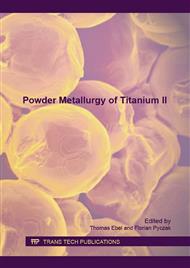[1]
M. W. Barsoum, MAX Phases. Properties of Machinable Ternary Carbides and Nitrides. Wiley VCH, (2013).
DOI: 10.1002/9783527654581
Google Scholar
[2]
B. M. Radovic and M. W. Barsoum, MAX phases : Bridging the gap between metals and ceramics, Am. Ceram. Soc. Bull., vol. 92, no. 3, p.20–27, (2013).
Google Scholar
[3]
Z. M. Sun, Progress in research and development on MAX phases: a family of layered ternary compounds, Int. Mater. Rev., vol. 56, no. 3, p.143–166, May (2011).
DOI: 10.1179/1743280410y.0000000001
Google Scholar
[4]
M. W. Barsoum and M. Radovic, Elastic and Mechanical Properties of the MAX Phases, Annu. Rev. Mater. Res., vol. 41, no. 1, p.195–227, Aug. (2011).
DOI: 10.1146/annurev-matsci-062910-100448
Google Scholar
[5]
X. H. Wang and Y. C. Zhou, Layered Machinable and Electrically Conductive Ti2AlC and Ti3AlC2 Ceramics: a Review, J. Mater. Sci. Technol., vol. 26, no. 5, p.385–416, May (2010).
DOI: 10.1016/s1005-0302(10)60064-3
Google Scholar
[6]
W. B. Zhou, B. C. Mei, J. Q. Zhu, and X. L. Hong, Rapid synthesis of Ti2AlC by spark plasma sintering technique, Mater. Lett., vol. 59, no. 1, p.131–134, Jan. (2005).
DOI: 10.1016/j.matlet.2004.07.052
Google Scholar
[7]
A. Sommers, Q. Wang, X. Han, C. T'Joen, Y. Park, and A. Jacobi, Ceramics and ceramic matrix composites for heat exchangers in advanced thermal systems—A review, Appl. Therm. Eng., vol. 30, no. 11–12, p.1277–1291, Aug. (2010).
DOI: 10.1016/j.applthermaleng.2010.02.018
Google Scholar
[8]
A. R. Studart, U. T. Gonzenbach, E. Tervoort, and L. J. Gauckler, Processing routes to macroporous ceramics: A review, J. Am. Ceram. Soc., vol. 89, no. 6, p.1771–1789, Jun. (2006).
DOI: 10.1111/j.1551-2916.2006.01044.x
Google Scholar
[9]
Z. Sun, A. Murugaiah, T. Zhen, A. Zhou, and M. Barsoum, Microstructure and mechanical properties of porous Ti3SiC2, Acta Mater., vol. 53, no. 16, p.4359–4366, Sep. (2005).
DOI: 10.1016/j.actamat.2005.05.034
Google Scholar
[10]
C. R. Bowen and T. Thomas, Macro-porous Ti2AlC MAX-phase ceramics by the foam replication method, Ceram. Int., vol. 41, no. 9, p.12178–12185, Nov. (2015).
DOI: 10.1016/j.ceramint.2015.06.038
Google Scholar
[11]
B. Velasco, S. A. T. B. Ferrari, and E. Gordo, MAX Phases Foams Produced via a Powder Metallurgy Process Using a Water Soluble Space-Holder, Powder Metall., vol. 58, no. 2, p.95–99, (2014).
DOI: 10.1179/0032589915z.000000000226
Google Scholar
[12]
L. Hu, R. Benitez, S. Basu, I. Karaman, and M. Radovic, Processing and characterization of porous Ti2AlC with controlled porosity and pore size, Acta Mater., vol. 60, no. 18, p.6266–6277, Oct. (2012).
DOI: 10.1016/j.actamat.2012.07.052
Google Scholar
[13]
C. L. Zhou, T. W. L. Ngai, L. Lu, and Y. Y. Li, Fabrication and characterization of pure porous Ti3SiC2 with controlled porosity and pore features, Mater. Lett., vol. 131, p.280–283, Sep. (2014).
DOI: 10.1016/j.matlet.2014.05.198
Google Scholar
[14]
A. Laptev and M. Bram, Manufacturing hollow titanium parts by powder metallurgy route and space holder technique, Mater. Lett., vol. 160, p.101–103, Dec. (2015).
DOI: 10.1016/j.matlet.2015.07.094
Google Scholar
[15]
C. Wang, A. Zhou, L. Qi, and Y. Huang, Quantitative phase analysis in the Ti-Al-C ternary system by X-ray diffraction, Powder Diffr., vol. 20, no. 3, p.218–223, (2005).
DOI: 10.1154/1.1951687
Google Scholar
[16]
D. J. Tallman, M. Naguib, B. Anasori, and M. W. Barsoum, Tensile creep of Ti2AlC in air in the temperature range 1000–1150°C, Scr. Mater., vol. 66, no. 10, p.805–808, May (2012).
DOI: 10.1016/j.scriptamat.2012.02.015
Google Scholar


